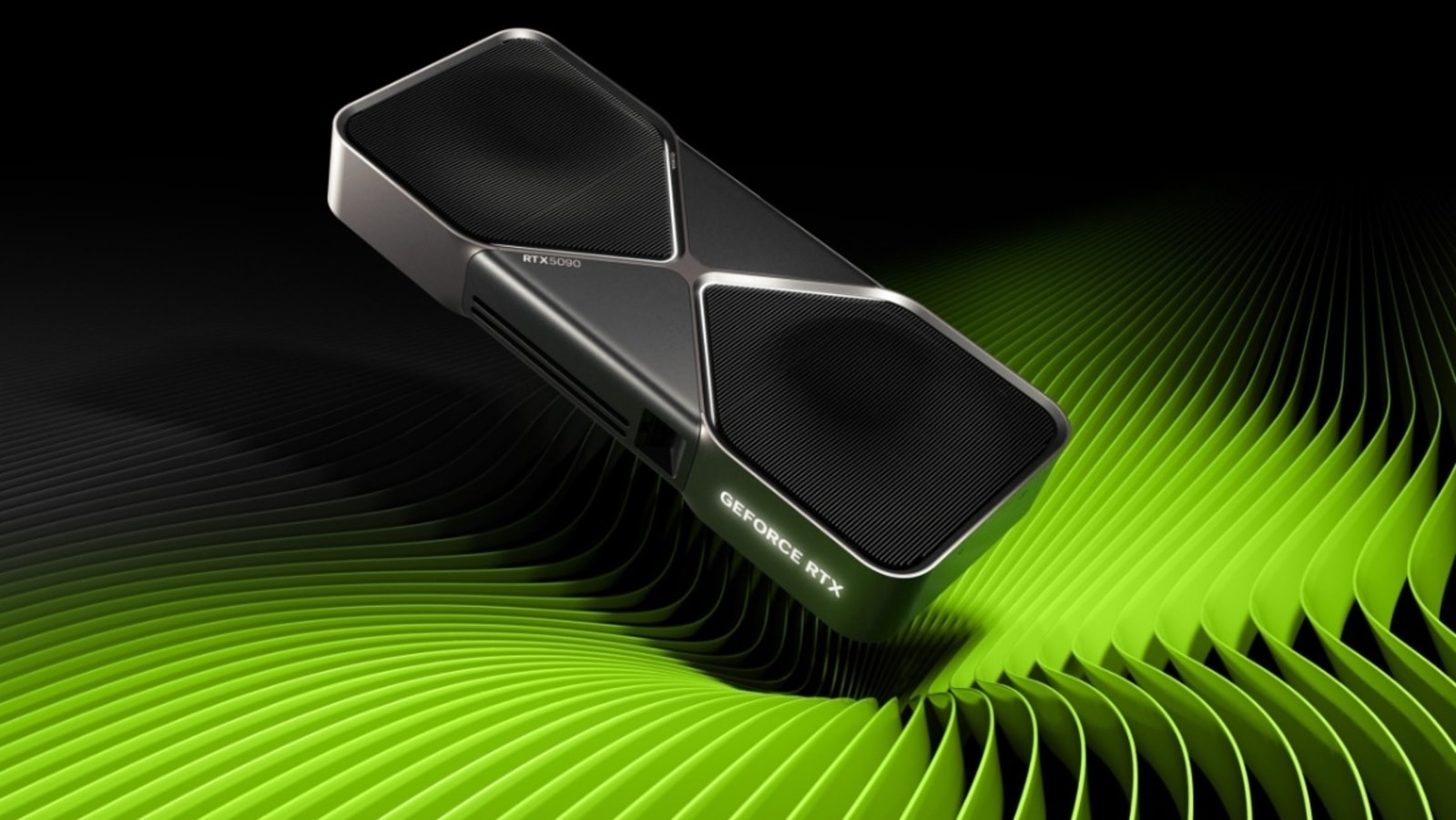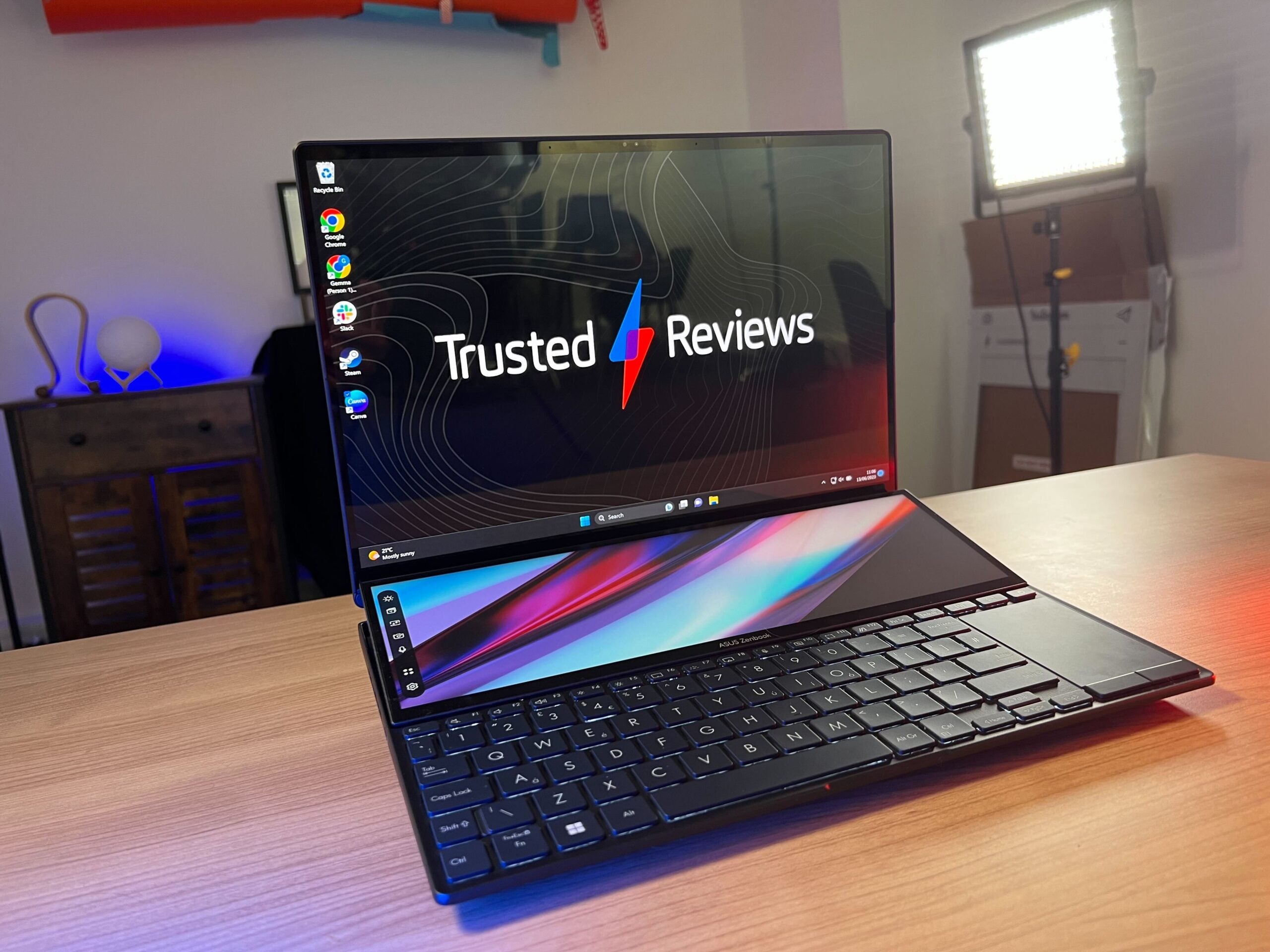Verdict
The Asus Zenbook Pro 14 Duo OLED (2023) comes with a whole host of amazing features, the most notable being its dual-screen design. This opens up an endless number of multitasking abilities and is further complimented by the powerful combo of a 13th-Gen Intel Core processor and Nvidia RTX 4060 graphics chip. But, to reap those benefits, you will have to deal with the pitiful battery life and cramped keyboard.
Pros
- OLED display looks incredibly vibrant
- ScreenPad Plus boosts productivity
- Keyboard is small but very reponsive
- Mature and sleek design
Cons
- Gets hot and loud very quickly – bundled stands are needed
- Awkward trackpad position
- Disappointing battery
Availability
- UKRRP: £1999.99
- USARRP: $1999.99
- EuropeRRP: €2799.00
- CanadaRRP: CA$3199.00
- AustraliaRRP: AU$3799.00
Key Features
-
Intel H-Series processorThis laptop can handle intensive workloads thanks to the Intel Core H-Series processor. -
OLED display Media is crisp and vibrant thanks to the 14.5-inch OLED display. -
Dual-screen design The Zenbook Pro 14 Duo OLED comes with a smaller ScreenPad Plus display mounted just above the keyboard, ideal for watching video content and multitasking.
Introduction
The Zenbook Pro 14 Duo OLED’s dual-screen design completely revolutionised how I go about my workday and now feels like a must-have for any hybrid worker.
The Zenbook Pro 14 Duo OLED feels like a breath of fresh air compared to the more traditional laptops out there. Asus kitted out this laptop with not one, but two displays to improve productivity and make multitasking easier.
Asus didn’t stop there, opting to use the blisteringly fast 13th generation Intel Core H-Series processor and an Nvidia RTX 4060 GPU which opens the doors to gaming and creativity workloads.
There are some downsides to this laptop, notably, its tendency to get very hot very fast and for the fans to run particularly loud. With that trade-off in mind, I found the Zenbook Pro 14 Duo OLED a joy to work on and a reliable contender for our best laptop roundup.
Design and Keyboard
- Sleek, mature design
- Keyboard had been squished to accommodate the second screen
- An external mouse is a necessity
- Stands come included in the box
Asus has been developing two-screened laptops for some time now and has almost mastered the formula. The secondary screen sits just above the keyboard at a perfect viewing angle. Stick-on stands are bundled in the box which helped to promote airflow and decrease wrist strain while typing.
The laptop is made entirely of metal and feels fantastic to use. My model weighs 1.75kg which is hefty for a 14-inch device, but understandable considering the extra screen and discrete GPU. It’s not the lightest laptop around, but I had no issues taking it on the go.
I love the mature design, with subtle branding that’s reminiscent of Star Trek. It’s simple but doesn’t veer into being boring, which is more than I can say for the identical Huawei MateBook series.
I was never at a loss for ports while using the Zenbook Pro 14 Duo OLED; it comes with a USB-A port, two USB-C Thunderbolt 4 ports, an HDMI 2.1 input as well as a 3.5mm audio jack and a MicroSD slot.
The secondary screen means the keyboard has been squished down towards the front of the bottom half of the laptop. Despite some trepidation, I had no issue with the smaller keyboard and was able to quickly write up articles and notes during Apple’s WWDC 2023 event. The keys have good feedback and travel, with a satisfying click.
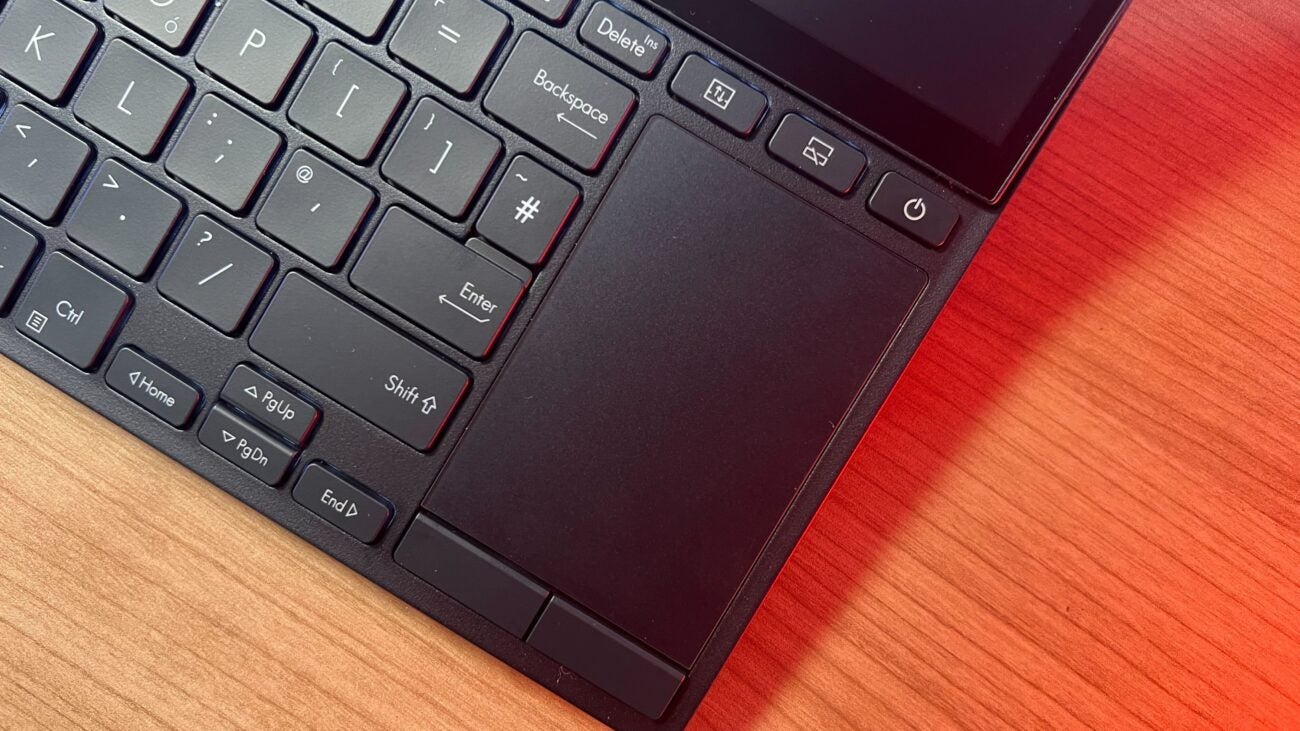
The real issue here is the trackpad. It’s been forced onto the right-hand side, making it completely unusable for left-handed people. It’s not very responsive and was cumbersome for highlighting large chunks of text. I would recommend using an external mouse with this laptop to avoid wrist strain; you can check out our best wireless mouse roundup by clicking on the link prior.
Display and Sound
- OLED display looks phenomenal
- Smaller ScreenPad Plus display makes multitasking a breeze
- Both displays have touchscreen support
- Colour accuracy falls a tad short for creative professionals
The primary screen on the Zenbook Pro 14 Duo OLED is fantastic. It achieved a perfect black level in our tests and 370 nits of brightness, and a faultless contrast of 1:1. Video content had so much depth and colours popped off the screen in nature documentaries on Disney Plus, making for a much more immersive experience.
The resolution sits at a sharp 2880×1800. The sRGB, Adobe RGB and DCI-P3 results came out at 99%, 75% and 75% respectively, making this suitable for creative professionals. The high colour accuracy meant that video content looked realistic, with no unwelcome blue or yellow hues present on white imagery.
The 120Hz refresh rate also opened up the door for gaming. Stardew Valley and Cuphead were both full of life, with animations looking effortless.
I can’t talk about the display without mentioning the secondary screen, the ScreenPad Plus. It sits at 12.7 inches, with a 2880×846 resolution and 60Hz refresh rate. Both screens feature touchscreen support, making scrolling through documents or editing images much easier.
The ScreenPad Plus can be turned on from the keyboard and configured from a small side menu. The App Navigator allowed me to position windows and apps to my liking, with Task Swap allowing me to quickly switch apps between screens.
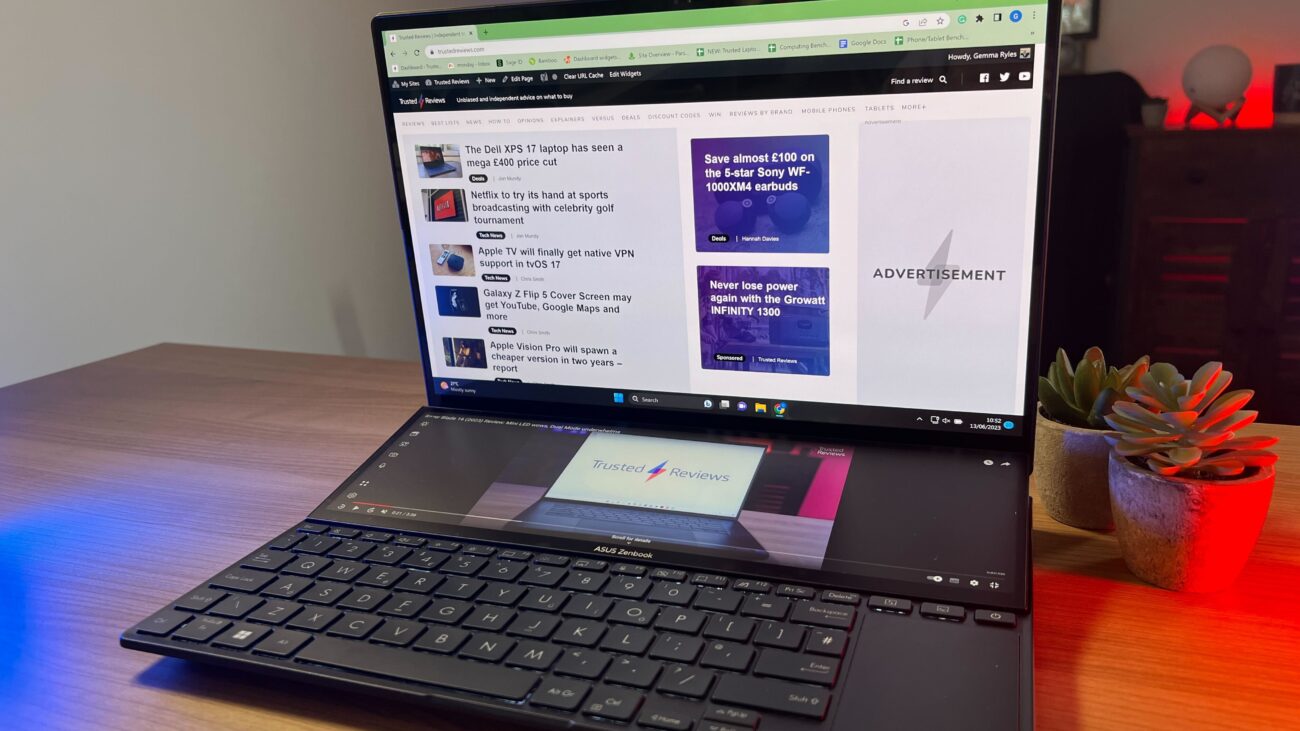
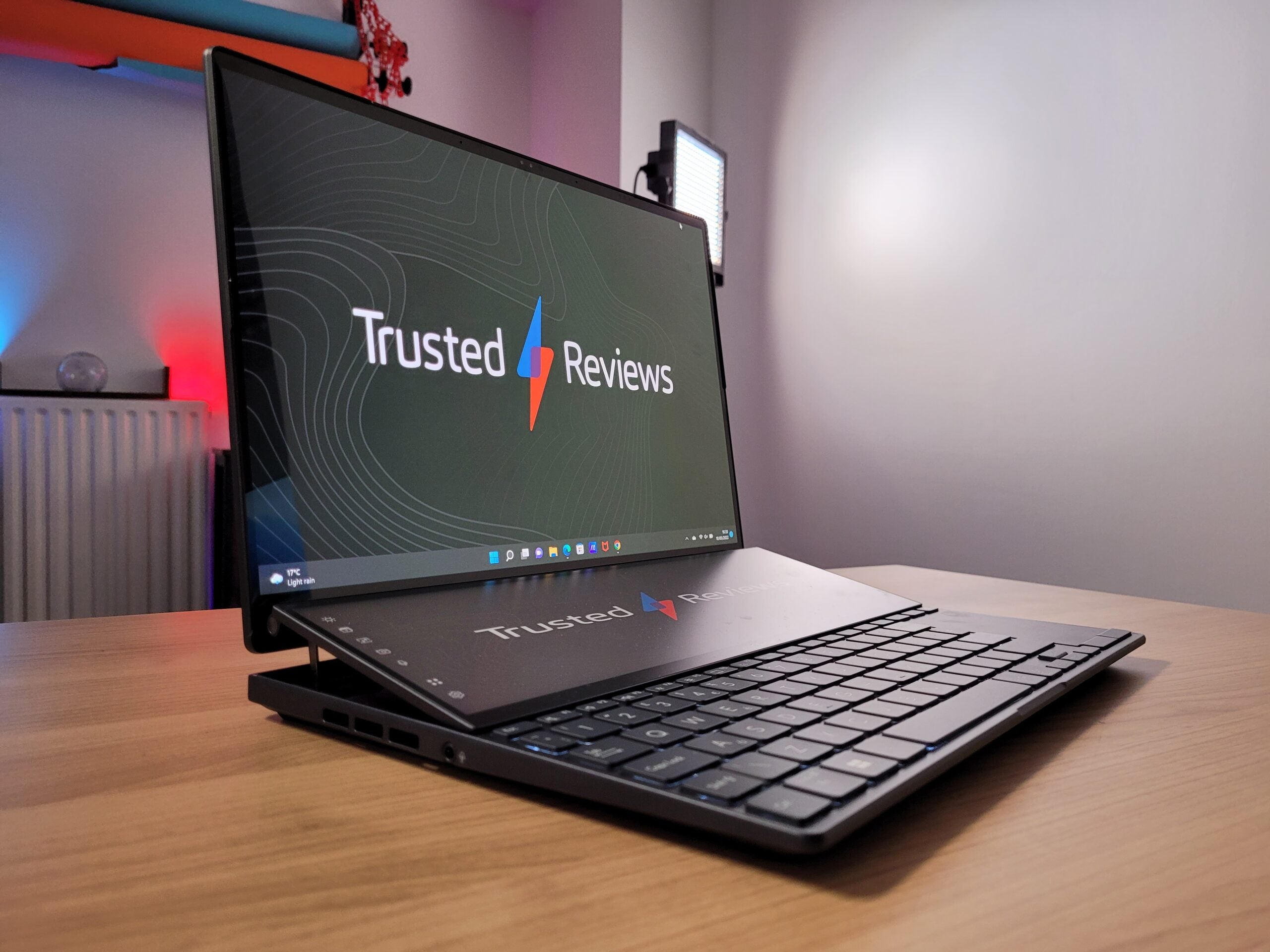
I love the ScreenPad Plus. The different uses for this secondary screen feel near-endless. It was incredibly easy to drag applications and browsers between both panels. I was able to work with my Slack channel open for easy viewing, flip between songs and Spotify and watch YouTube while replying to emails. I see gamers and content creatives getting more use out of this than I did, but it came in handy every time I opened the laptop lid.
The cramped keyboard and unresponsive, small trackpad are clear downsides to the Zenbook Pro 14 Duo OLED. However, I feel that the boost in productivity from the ScreenPad Plus is a lot more alluring and ideal for anyone without the room or space to invest in an external monitor.
Despite their small size, the speakers offer up a lot of punch. It filled up my bedroom with tunes and TV shows alike and had a lot of vibrancy. It can’t compare to some of the best speakers out there, but it’s got more than enough oomph for a laptop.
Performance
- Blisteringly fast Intel Core H-Series processor
- Enough GPU grunt for gaming
- Does run hot and loud
The Zenbook Pro 14 Duo OLED comes with some very impressive internals. My model came with an Intel Core i9-13900H processor alongside an Nvidia RTX 4060 GPU. It can’t compare to some other laptops on the market, but it thrived in the multi-threaded tests, with a high enough single-core score to make it a reliable gaming machine.
The inclusion of a 13th-generation (Raptor Lake) H-series chip means this laptop can handle productivity work like it’s nothing. It took a lot to get this machine to stutter and I was able to work with over two dozen tabs open, including graphically intensive apps like Canva, without anything going awry. SSD speeds were up to standard too, at a speedy 6,724.56MB/s read and 5,156.38MB/s write, allowing for swift file transfers.
As you can see from the benchmarking results above, the Zenbook Pro 14 Duo OLED was continually outmatched by its own sibling, the Asus Zenbook Pro 14 OLED (2023). Despite that, it managed to beat out the other two laptops in the multi-core test, proving its capabilities for intensive productivity tasks.
I ran a few tests in Cyberpunk 2077 to fully grasp the gaming capabilities of the Zenbook Pro 14 Duo OLED, and the results were very promising. Most impressively, I was able to hit 59fps with a Quad HD (2560×1440) resolution with DLSS 3 turned on. With ray tracing and DLSS 3 enabled, it managed to hit 43fps in Quad HD, making it a reliable gaming machine.
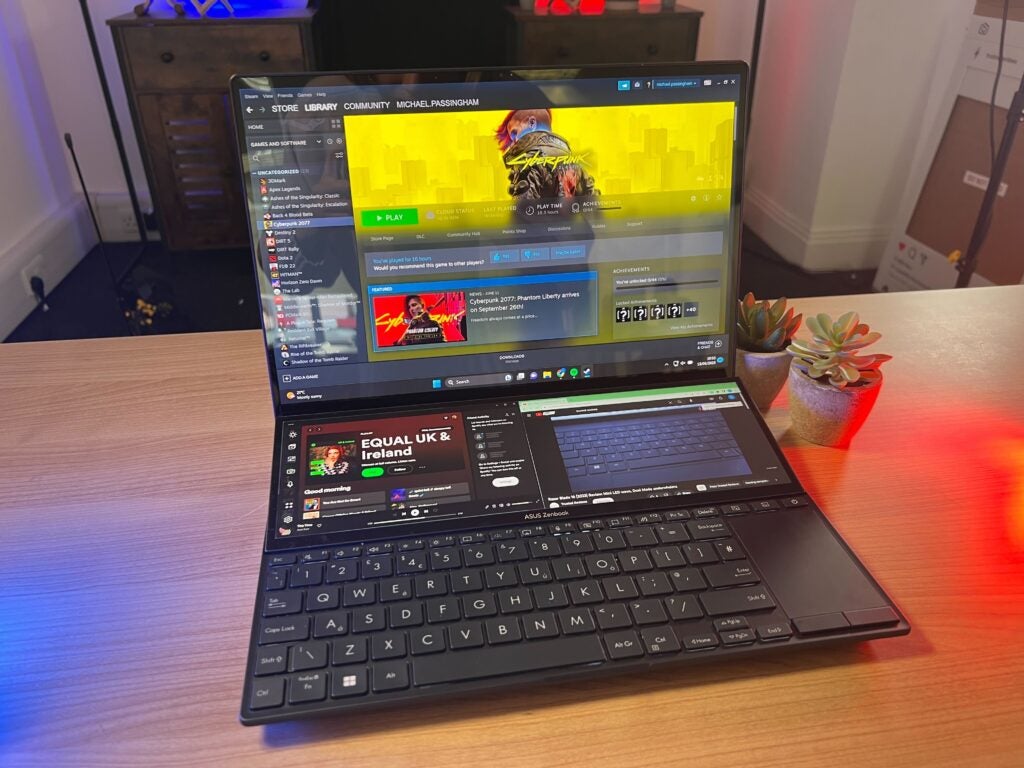
Playing Stardew Valley felt smooth and ran without any hitches, while the visuals looked crisp and vibrant. My faultless gaming experience bolsters my view of the Zenbook Pro 14 Duo OLED as a fantastically versatile machine, one that’s ideal for both work and play.
However, this laptop is not without its downsides. If the ScreenPad Plus was turned on, it would heat up immediately, regardless of what tasks I was engaging in. The same can be said for the fans, but they only got too loud when I was gaming or working with multiple tabs open. Asus did include some stick-on bundled stands to alleviate this, and I think they are a necessity. Not only do they tilt the ScreenPad Plus to a more comfortable angle but it allows for much-improved airflow, leading me to recommend using them at all times.
Battery Life
- The battery life of a gaming computer
- Lasted longer with the secondary display disabled
The weakest point for the Zenbook Pro 14 Duo OLED is the battery life. Having the second screen on does drain the battery at a noticeably quicker pace, with my PCMark 10 battery benchmark test lasting for 4 hours and 2 minutes before shutting down.
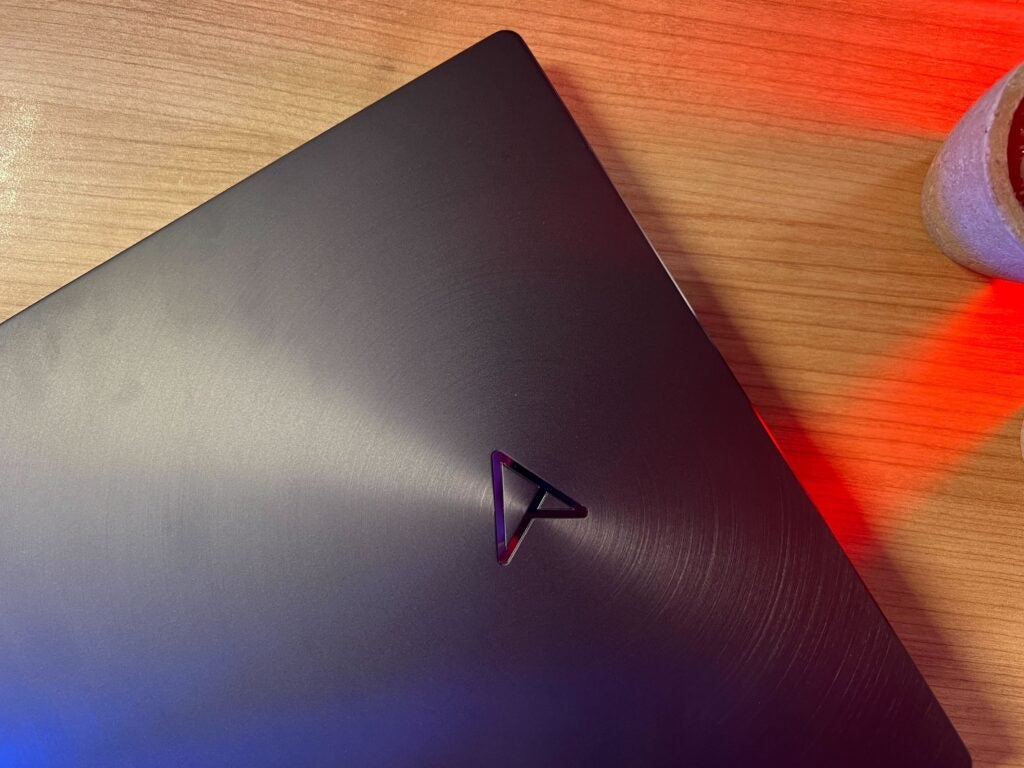
Using just the main display does improve this, but it’s still a pitiful performance. It lasted for 6 hours and 4 minutes, putting it on par with many gaming laptops in terms of battery life. I was not able to use it over a full workday without needing to reach for a charger, and the laptop performed notably better when plugged in.
All this is to say that you will need to make sure you bring the charger if you do take the Zenbook Pro 14 Duo OLED out on the go. If you want something that can last a little longer, I would recommend looking at the Asus Zenbook Pro 14 OLED, which we found had 8 hours of real-world battery life.
Latest deals
Should you buy it?
You want two displays without investing in an external monitor
The ScreenPad Plus display is invaluable during day-to-day use and adds another dimension to your workday. Thanks to the powerful RTX 4060 GPU, gaming and creative workloads are also more than doable.
You don’t want the drawbacks of the ScreenPad Plus
The addition of a secondary screen brings about key issues, notably the poor battery life, small keyboard and unresponsive trackpad.
Final Thoughts
The Asus Zenbook Pro 14 Duo OLED has some fantastic highs and some disappointing lows. It goes without saying that the ScreenPad Plus provides so many benefits and I can see it being a game-changer for creative apps like Photoshop and Premiere Pro. The H-Series Intel chip and RTX 4060 provided a massive amount of power and open the door for gaming and creative workloads, making this an incredibly versatile machine.
But all that power does result in the laptop running quite hot and a pitful battery life that feels more apt for a gaming device. The smaller keyboard didn’t bother me, but it may be a hard adjustment for anyone who’s used to using a full-sized laptop. In that case, I would recommend the one-screened Asus Zenbook Pro 14 OLED (2023) or the mighty HP Dragonfly Pro (2023).
The Asus Zenbook Pro 14 Duo OLED won’t be for everyone. But if you’re interested in using a secondary monitor but don’t have the space or funds for an external device, this could be the perfect solution. Just make sure you have an external mouse handy.
How we test
Every laptop we review goes through a series of uniform checks designed to gauge key things including build quality, performance, screen quality and battery life.
These include formal synthetic benchmarks and scripted tests, plus a series of real world checks.
Tested the performance via both benchmark tests and real-world use.
We tested the screen with a colorimeter and real-world use.
We tested the battery with a benchmark test and real-world use.
FAQs
Yes, both the main and smaller display on the Zenbook Pro 14 Duo OLED have touchscreen capabilities.
As shown by our benchmarking data, the Zenbook Pro 14 Duo OLED is capable of playing AAA games with a high frame rate in Full or Quad HD.
Trusted Reviews test data
UK RRP
USA RRP
EU RRP
CA RRP
AUD RRP
CPU
Manufacturer
Screen Size
Storage Capacity
Front Camera
Battery
Battery Hours
Size (Dimensions)
Weight
Operating System
Release Date
Model Number
Model Variants
Resolution
HDR
Refresh Rate
Ports
GPU
RAM
Connectivity
Colours
Screen Technology
Touch Screen
Convertible?
Verdict
The Asus Zenbook Pro 14 Duo OLED (2023) comes with a whole host of amazing features, the most notable being its dual-screen design. This opens up an endless number of multitasking abilities and is further complimented by the powerful combo of a 13th-Gen Intel Core processor and Nvidia RTX 4060 graphics chip. But, to reap those benefits, you will have to deal with the pitiful battery life and cramped keyboard.
Pros
- OLED display looks incredibly vibrant
- ScreenPad Plus boosts productivity
- Keyboard is small but very reponsive
- Mature and sleek design
Cons
- Gets hot and loud very quickly – bundled stands are needed
- Awkward trackpad position
- Disappointing battery
Availability
- UKRRP: £1999.99
- USARRP: $1999.99
- EuropeRRP: €2799.00
- CanadaRRP: CA$3199.00
- AustraliaRRP: AU$3799.00
Key Features
-
Intel H-Series processorThis laptop can handle intensive workloads thanks to the Intel Core H-Series processor. -
OLED display Media is crisp and vibrant thanks to the 14.5-inch OLED display. -
Dual-screen design The Zenbook Pro 14 Duo OLED comes with a smaller ScreenPad Plus display mounted just above the keyboard, ideal for watching video content and multitasking.
Introduction
The Zenbook Pro 14 Duo OLED’s dual-screen design completely revolutionised how I go about my workday and now feels like a must-have for any hybrid worker.
The Zenbook Pro 14 Duo OLED feels like a breath of fresh air compared to the more traditional laptops out there. Asus kitted out this laptop with not one, but two displays to improve productivity and make multitasking easier.
Asus didn’t stop there, opting to use the blisteringly fast 13th generation Intel Core H-Series processor and an Nvidia RTX 4060 GPU which opens the doors to gaming and creativity workloads.
There are some downsides to this laptop, notably, its tendency to get very hot very fast and for the fans to run particularly loud. With that trade-off in mind, I found the Zenbook Pro 14 Duo OLED a joy to work on and a reliable contender for our best laptop roundup.
Design and Keyboard
- Sleek, mature design
- Keyboard had been squished to accommodate the second screen
- An external mouse is a necessity
- Stands come included in the box
Asus has been developing two-screened laptops for some time now and has almost mastered the formula. The secondary screen sits just above the keyboard at a perfect viewing angle. Stick-on stands are bundled in the box which helped to promote airflow and decrease wrist strain while typing.
The laptop is made entirely of metal and feels fantastic to use. My model weighs 1.75kg which is hefty for a 14-inch device, but understandable considering the extra screen and discrete GPU. It’s not the lightest laptop around, but I had no issues taking it on the go.
I love the mature design, with subtle branding that’s reminiscent of Star Trek. It’s simple but doesn’t veer into being boring, which is more than I can say for the identical Huawei MateBook series.
I was never at a loss for ports while using the Zenbook Pro 14 Duo OLED; it comes with a USB-A port, two USB-C Thunderbolt 4 ports, an HDMI 2.1 input as well as a 3.5mm audio jack and a MicroSD slot.
The secondary screen means the keyboard has been squished down towards the front of the bottom half of the laptop. Despite some trepidation, I had no issue with the smaller keyboard and was able to quickly write up articles and notes during Apple’s WWDC 2023 event. The keys have good feedback and travel, with a satisfying click.

The real issue here is the trackpad. It’s been forced onto the right-hand side, making it completely unusable for left-handed people. It’s not very responsive and was cumbersome for highlighting large chunks of text. I would recommend using an external mouse with this laptop to avoid wrist strain; you can check out our best wireless mouse roundup by clicking on the link prior.
Display and Sound
- OLED display looks phenomenal
- Smaller ScreenPad Plus display makes multitasking a breeze
- Both displays have touchscreen support
- Colour accuracy falls a tad short for creative professionals
The primary screen on the Zenbook Pro 14 Duo OLED is fantastic. It achieved a perfect black level in our tests and 370 nits of brightness, and a faultless contrast of 1:1. Video content had so much depth and colours popped off the screen in nature documentaries on Disney Plus, making for a much more immersive experience.
The resolution sits at a sharp 2880×1800. The sRGB, Adobe RGB and DCI-P3 results came out at 99%, 75% and 75% respectively, making this suitable for creative professionals. The high colour accuracy meant that video content looked realistic, with no unwelcome blue or yellow hues present on white imagery.
The 120Hz refresh rate also opened up the door for gaming. Stardew Valley and Cuphead were both full of life, with animations looking effortless.
I can’t talk about the display without mentioning the secondary screen, the ScreenPad Plus. It sits at 12.7 inches, with a 2880×846 resolution and 60Hz refresh rate. Both screens feature touchscreen support, making scrolling through documents or editing images much easier.
The ScreenPad Plus can be turned on from the keyboard and configured from a small side menu. The App Navigator allowed me to position windows and apps to my liking, with Task Swap allowing me to quickly switch apps between screens.


I love the ScreenPad Plus. The different uses for this secondary screen feel near-endless. It was incredibly easy to drag applications and browsers between both panels. I was able to work with my Slack channel open for easy viewing, flip between songs and Spotify and watch YouTube while replying to emails. I see gamers and content creatives getting more use out of this than I did, but it came in handy every time I opened the laptop lid.
The cramped keyboard and unresponsive, small trackpad are clear downsides to the Zenbook Pro 14 Duo OLED. However, I feel that the boost in productivity from the ScreenPad Plus is a lot more alluring and ideal for anyone without the room or space to invest in an external monitor.
Despite their small size, the speakers offer up a lot of punch. It filled up my bedroom with tunes and TV shows alike and had a lot of vibrancy. It can’t compare to some of the best speakers out there, but it’s got more than enough oomph for a laptop.
Performance
- Blisteringly fast Intel Core H-Series processor
- Enough GPU grunt for gaming
- Does run hot and loud
The Zenbook Pro 14 Duo OLED comes with some very impressive internals. My model came with an Intel Core i9-13900H processor alongside an Nvidia RTX 4060 GPU. It can’t compare to some other laptops on the market, but it thrived in the multi-threaded tests, with a high enough single-core score to make it a reliable gaming machine.
The inclusion of a 13th-generation (Raptor Lake) H-series chip means this laptop can handle productivity work like it’s nothing. It took a lot to get this machine to stutter and I was able to work with over two dozen tabs open, including graphically intensive apps like Canva, without anything going awry. SSD speeds were up to standard too, at a speedy 6,724.56MB/s read and 5,156.38MB/s write, allowing for swift file transfers.
As you can see from the benchmarking results above, the Zenbook Pro 14 Duo OLED was continually outmatched by its own sibling, the Asus Zenbook Pro 14 OLED (2023). Despite that, it managed to beat out the other two laptops in the multi-core test, proving its capabilities for intensive productivity tasks.
I ran a few tests in Cyberpunk 2077 to fully grasp the gaming capabilities of the Zenbook Pro 14 Duo OLED, and the results were very promising. Most impressively, I was able to hit 59fps with a Quad HD (2560×1440) resolution with DLSS 3 turned on. With ray tracing and DLSS 3 enabled, it managed to hit 43fps in Quad HD, making it a reliable gaming machine.

Playing Stardew Valley felt smooth and ran without any hitches, while the visuals looked crisp and vibrant. My faultless gaming experience bolsters my view of the Zenbook Pro 14 Duo OLED as a fantastically versatile machine, one that’s ideal for both work and play.
However, this laptop is not without its downsides. If the ScreenPad Plus was turned on, it would heat up immediately, regardless of what tasks I was engaging in. The same can be said for the fans, but they only got too loud when I was gaming or working with multiple tabs open. Asus did include some stick-on bundled stands to alleviate this, and I think they are a necessity. Not only do they tilt the ScreenPad Plus to a more comfortable angle but it allows for much-improved airflow, leading me to recommend using them at all times.
Battery Life
- The battery life of a gaming computer
- Lasted longer with the secondary display disabled
The weakest point for the Zenbook Pro 14 Duo OLED is the battery life. Having the second screen on does drain the battery at a noticeably quicker pace, with my PCMark 10 battery benchmark test lasting for 4 hours and 2 minutes before shutting down.

Using just the main display does improve this, but it’s still a pitiful performance. It lasted for 6 hours and 4 minutes, putting it on par with many gaming laptops in terms of battery life. I was not able to use it over a full workday without needing to reach for a charger, and the laptop performed notably better when plugged in.
All this is to say that you will need to make sure you bring the charger if you do take the Zenbook Pro 14 Duo OLED out on the go. If you want something that can last a little longer, I would recommend looking at the Asus Zenbook Pro 14 OLED, which we found had 8 hours of real-world battery life.
Latest deals
Should you buy it?
You want two displays without investing in an external monitor
The ScreenPad Plus display is invaluable during day-to-day use and adds another dimension to your workday. Thanks to the powerful RTX 4060 GPU, gaming and creative workloads are also more than doable.
You don’t want the drawbacks of the ScreenPad Plus
The addition of a secondary screen brings about key issues, notably the poor battery life, small keyboard and unresponsive trackpad.
Final Thoughts
The Asus Zenbook Pro 14 Duo OLED has some fantastic highs and some disappointing lows. It goes without saying that the ScreenPad Plus provides so many benefits and I can see it being a game-changer for creative apps like Photoshop and Premiere Pro. The H-Series Intel chip and RTX 4060 provided a massive amount of power and open the door for gaming and creative workloads, making this an incredibly versatile machine.
But all that power does result in the laptop running quite hot and a pitful battery life that feels more apt for a gaming device. The smaller keyboard didn’t bother me, but it may be a hard adjustment for anyone who’s used to using a full-sized laptop. In that case, I would recommend the one-screened Asus Zenbook Pro 14 OLED (2023) or the mighty HP Dragonfly Pro (2023).
The Asus Zenbook Pro 14 Duo OLED won’t be for everyone. But if you’re interested in using a secondary monitor but don’t have the space or funds for an external device, this could be the perfect solution. Just make sure you have an external mouse handy.
How we test
Every laptop we review goes through a series of uniform checks designed to gauge key things including build quality, performance, screen quality and battery life.
These include formal synthetic benchmarks and scripted tests, plus a series of real world checks.
Tested the performance via both benchmark tests and real-world use.
We tested the screen with a colorimeter and real-world use.
We tested the battery with a benchmark test and real-world use.
FAQs
Yes, both the main and smaller display on the Zenbook Pro 14 Duo OLED have touchscreen capabilities.
As shown by our benchmarking data, the Zenbook Pro 14 Duo OLED is capable of playing AAA games with a high frame rate in Full or Quad HD.
Trusted Reviews test data
UK RRP
USA RRP
EU RRP
CA RRP
AUD RRP
CPU
Manufacturer
Screen Size
Storage Capacity
Front Camera
Battery
Battery Hours
Size (Dimensions)
Weight
Operating System
Release Date
Model Number
Model Variants
Resolution
HDR
Refresh Rate
Ports
GPU
RAM
Connectivity
Colours
Screen Technology
Touch Screen
Convertible?


